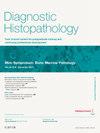多发性肿瘤患者的分期:整合形态学和分子谱
引用次数: 0
摘要
随着肺癌诊断和治疗水平的提高,患者同时患有一种以上肺癌的现象越来越多。第二癌是否被认为是单独的原发性肺癌或肺内转移,从根本上改变了分期,对治疗决策至关重要。肿瘤的组织学比较通常是区分单独原发性肺癌和肺内转移的有效工具。基因组分析的出现为我们的武器库带来了另一个强大的工具。虽然有令人信服的证据表明这两种方法都能准确地解决大多数病例,但两者都不是没有局限性的,而且很容易屈服于组织学和基因组评估的陷阱。需要病理学家的综合方法来优化这些判断,病理学家必须熟练识别鉴别组织学特征,并且在癌症的分子进化和分子技术的局限性方面有良好的基础。在这篇综述中,我们讨论的工具,可以带来承担分类多重肺癌的困境。我们首先回顾临床和影像学线索,然后讨论组织学比较的价值,最后讨论分子谱分析可以带来的价值。本文章由计算机程序翻译,如有差异,请以英文原文为准。
Staging in patients with multiple tumours: integrating morphology and molecular profiling
With improvements in lung cancer diagnosis and management, the phenomenon of patients having more than one lung cancer is becoming increasingly frequent. Whether a second cancer is considered a separate primary lung cancer or an intrapulmonary metastasis fundamentally changes the staging and can have critical importance for treatment decisions. Histological comparison of cancers is often an effective tool in discriminating between separate primary lung cancer and intrapulmonary metastasis. The advent of genomic profiling has brought another powerful tool to our arsenal. While there is compelling evidence that both approaches accurately resolve the majority of cases, neither is without limitations and it is easy to succumb to pitfalls from both histological and genomic assessment. A combined approach by a pathologist who is skilled in recognizing discriminating histological features, and who has a good grounding in the molecular evolution of cancers and in the limitations of molecular techniques, is required to optimize these judgements. In this review, we discuss the tools which can be brought to bear on the dilemma of classifying multiple lung cancers. We begin by reviewing the clinical and radiological clues, before discussing the value of histological comparison, and finally the value which molecular profiling can bring.
求助全文
通过发布文献求助,成功后即可免费获取论文全文。
去求助
来源期刊

Diagnostic Histopathology
Medicine-Pathology and Forensic Medicine
CiteScore
1.30
自引率
0.00%
发文量
64
期刊介绍:
This monthly review journal aims to provide the practising diagnostic pathologist and trainee pathologist with up-to-date reviews on histopathology and cytology and related technical advances. Each issue contains invited articles on a variety of topics from experts in the field and includes a mini-symposium exploring one subject in greater depth. Articles consist of system-based, disease-based reviews and advances in technology. They update the readers on day-to-day diagnostic work and keep them informed of important new developments. An additional feature is the short section devoted to hypotheses; these have been refereed. There is also a correspondence section.
 求助内容:
求助内容: 应助结果提醒方式:
应助结果提醒方式:


